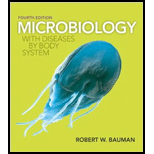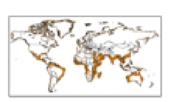
Concept explainers
Vibrio vulnificus Infection

Greg enjoyed Florida’s beaches; swimming in the warm water was his favorite pastime. Of course, the salt water did sting his leg where he had cut himself on some coral, but it didn’t sting enough to stop Greg from enjoying the beach. He spent the afternoon jogging in the pure sand, throwing a disc, watching people, drinking a few beers, and of course spending more time in the water.
That evening, he felt chilled, a condition he associated with having gotten too much sun during the day, but by midnight he thought he must have caught a rare summertime flu. He was definitely feverish, extremely weak, and tired. His leg felt strangely tight, as though the underlying muscles were trying to burst through his skin.
The next morning, he felt better, except for his leg. It was swollen, dark red, tremendously painful, and covered with fluid-filled blisters. The ugly sight motivated him to head straight for the hospital, a decision that like y saved his life.
Greg was the victim of an emerging pathogen, Vibrio vulnificus–a slightly curved, Gram-negative bacterium with DNA similar to that of V cholerae (cholera bacterium). V vulnificus lives in salty, warm water around the globe. Unlike the cholera bacterium, V vulnificus is able 10 infect a person by penetrating directly into a deep wound, a cut, or even a tiny scratch. In a person, the multiplying bacterium secretes quorum-sensing molecules. When the cells sense that there is a certain

Greg’s doctor cut away the dead tissue and prescribed doxycycline and cephalosporin for two weeks. Greg survived and kept his leg. Half of the victims of V. vulnificus are not so lucky; they lose a limb or die. Who knew that a beach could be so dangerous? (For more about quorum sensing, see pp.167-169.)
- 1. Why is it necessary for Vibrio vulnificus to turn on different genes when the microbe invades a human?
- 2. What does the term “turn on” mean in relation to transcription and translation?
- 3. Why do you think the related microbe V. cholerae is unable to infect through the skin?
Want to see the full answer?
Check out a sample textbook solution
Chapter 7 Solutions
Microbiology with Diseases by Body System (4th Edition)
- Molecular Biology Question. Please help with step solution and explanation. Thank you: The Polymerase Chain Reaction (PCR) reaction consists of three steps denaturation, hybridization, and elongation. Please describe what occurs in the annealing step of the PCR reaction. (I think annealing step is hybridization). What are the other two steps of PCR, and what are their functions? Next, suppose the Tm for the two primers being used are 54C for Primer A and 67C for Primer B. Regarding annealing step temperature, I have the following choices for the temperature used during the annealing step:(a) 43C (b) 49C (c) 62C (d) 73C Which temperature/temperatures should I choose? What is the corresponding correct explanation, and why would I not use the other temperatures? Have a good day!arrow_forwardUsing the data provided on the mean body mass and horn size of 4-year-old male sheep, draw a scatterplot graph to examine how body mass and horn size changed over time.arrow_forwardPlease write a 500-word report about the intake of saturated fat, sodium, alcoholic beverages, or added sugar in America. Choose ONE of these and write about what is recommended by the Dietary Guidelines for Americans (guideline #4) and why Americans exceed the intake of that nutrient. Explain what we could do as a society and/or individuals to reduce our intake of your chosen nutrient.arrow_forward
- Write a 500-word report indicating how you can change the quantity or quality of TWO nutrients where your intake was LOWER than what is recommended by the Dietary Guidelines for Americans and/or the DRIs. Indicate how the lack of the nutrient may affect your health. For full credit, all of the following points must be addressed and elaborated on in more detail for each nutrient: The name of the nutrient At least 2 main functions of the nutrient (example: “Vitamin D regulates calcium levels in the blood and calcification of bones.”) Your percent intake compared to the RDA/DRI (example “I consumed 50% of the RDA for vitamin D”) Indicate why your intake was below the recommendations (example: “I only had one serving of dairy products and that was why I was below the recommendations for vitamin D”) How would you change your dietary pattern to meet the recommendations? – be sure to list specific foods (example: “I would add a yogurt and a glass of milk to each day in order to increase my…arrow_forwardWhy are nutrient absorption and dosage levels important when taking multivitamins and vitamin and mineral supplements?arrow_forwardI'm struggling with this topic and would really appreciate your help. I need to hand-draw a diagram and explain the process of sexual differentiation in humans, including structures, hormones, enzymes, and other details. Could you also make sure to include these terms in the explanation? . Gonads . Wolffian ducts • Müllerian ducts . ⚫ Testes . Testosterone • Anti-Müllerian Hormone (AMH) . Epididymis • Vas deferens ⚫ Seminal vesicles ⚫ 5-alpha reductase ⚫ DHT - Penis . Scrotum . Ovaries • Uterus ⚫ Fallopian tubes - Vagina - Clitoris . Labia Thank you so much for your help!arrow_forward
- Requisition Exercise A phlebotomist goes to a patient’s room with the following requisition. Hometown Hospital USA 125 Goodcare Avenue Small Town, USAarrow_forwardI’m struggling with this topic and would really appreciate your help. I need to hand-draw a diagram and explain the process of sexual differentiation in humans, including structures, hormones, enzymes, and other details. Could you also make sure to include these terms in the explanation? • Gonads • Wolffian ducts • Müllerian ducts • Testes • Testosterone • Anti-Müllerian Hormone (AMH) • Epididymis • Vas deferens • Seminal vesicles • 5-alpha reductase • DHT • Penis • Scrotum • Ovaries • Uterus • Fallopian tubes • Vagina • Clitoris • Labia Thank you so much for your help!arrow_forwardI’m struggling with this topic and would really appreciate your help. I need to hand-draw a diagram and explain the process of sexual differentiation in humans, including structures, hormones, enzymes, and other details. Could you also make sure to include these terms in the explanation? • Gonads • Wolffian ducts • Müllerian ducts • Testes • Testosterone • Anti-Müllerian Hormone (AMH) • Epididymis • Vas deferens • Seminal vesicles • 5-alpha reductase • DHT • Penis • Scrotum • Ovaries • Uterus • Fallopian tubes • Vagina • Clitoris • Labia Thank you so much for your help!arrow_forward
- Older adults have unique challenges in terms of their nutrient needs and physiological changes. Some changes may make it difficult to consume a healthful diet, so it is important to identify strategies to help overcome these obstacles. From the list below, choose all the correct statements about changes in older adults. Select all that apply. Poor vision can make it difficult for older adults to get to a supermarket, and to prepare meals. With age, taste and visual perception decline. As people age, salivary production increases. In older adults with dysphagia, foods like creamy soups, applesauce, and yogurt are usually well tolerated. Lean body mass increases in older adults.arrow_forwardWhen physical activity increases, energy requirements increase also. Depending on the type, intensity, and duration of physical activity, the body’s requirements for certain macronutrients may change as well. From the list below, choose all the correct statements about the effects of increased physical activity or athletic training. Select all that apply. An athlete who weighs 70 kg (154 lb) should consume 420 to 700 g of carbohydrate per day. How much additional energy an athlete needs depends on the specific activity the athlete engages in and the frequency of the activity. Those participating in vigorous exercise should restrict their fat intake to less than 15%% of total energy intake. Athletes who are following energy-restricted diets are at risk for consuming insufficient protein. The recommendation to limit saturated fat intake to less than 10%% of total energy intake does not apply to athletes or those who regularly engage in vigorous physical activity.arrow_forwardWhen taking vitamins and vitamin-mineral supplements, how can one be sure they are getting what they are taking?arrow_forward
- Lifetime Physical Fitness & WellnessHealth & NutritionISBN:9781337677509Author:HOEGERPublisher:Cengage
 Human Biology (MindTap Course List)BiologyISBN:9781305112100Author:Cecie Starr, Beverly McMillanPublisher:Cengage LearningUnderstanding Health Insurance: A Guide to Billin...Health & NutritionISBN:9781337679480Author:GREENPublisher:Cengage
Human Biology (MindTap Course List)BiologyISBN:9781305112100Author:Cecie Starr, Beverly McMillanPublisher:Cengage LearningUnderstanding Health Insurance: A Guide to Billin...Health & NutritionISBN:9781337679480Author:GREENPublisher:Cengage  Concepts of BiologyBiologyISBN:9781938168116Author:Samantha Fowler, Rebecca Roush, James WisePublisher:OpenStax College
Concepts of BiologyBiologyISBN:9781938168116Author:Samantha Fowler, Rebecca Roush, James WisePublisher:OpenStax College





